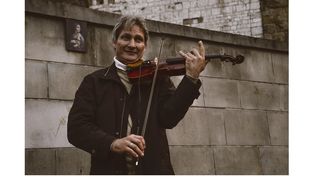Play
Musical Fingerings
How violinists and other musicians choose fingerings says a lot about planning.
Posted November 23, 2017

When I meet with students interested in doing research in psychology, I try to suggest topics that interest them and might help them make a name for themselves. Is there a topic that no one (or hardly anyone) has researched before that would interest the student, that would build on the student's strengths, and that would provide a vehicle for extending the student's capabilities and also help the student land a place in graduate school or a position after that? Of course, I suggest topics that excite me too so I can help guide the work and have something to show for it myself. I have suggested several such topics in previous blogs. Here is another.
If you play the violin or other instrument where you need to decide which fingers to use when, you know that settling on musical fingerings can be a challenge. You can "paint by the numbers," so to speak, by using the fingers called for in the score, but if you have to decide on the fingerings yourself, it can be difficult. Some musicians write down the fingerings they want. If they are renowned players, their fingerings may be printed in the scores they edit and their identities may be touted on the front cover of the music. In my own case, when I can't rely on the fingerings of others, I tend to write in fingerings in spots where it's not obvious which fingers to use. (I play the violin on a regular basis and have done so since I was 9 years old.) When I return to the same piece later on, I find it helpful to have those fingerings written in because they reduce the amount of on-the-spot figuring I have to do.
What is the nature of the fingering planning process? Surprisingly, the topic has not been studied by psychologists interested in musical performance, at least as far as I know. When I used the internet to look for previous work on the topic, I found only two studies. One was an AI program designed to automatically generate violin fingerings given note-sequence inputs (http://www.violinist.com/blog/pooispoois/201612/20903/). I didn't explore the output or method of that artificial-intelligence program in detail but noted that its example output referred to the number of possible solutions considered for the passage in question (whose length, in number of notes, wasn't clear to me): 1,060,901. That's a lot of possible solutions! Fortunately, the author's computer was quick. The best solution was found in 4,483 milliseconds, or just under half a second.
When violinists figure out which fingerings to use while sight reading, it's doubtful that they consider over a million possible solutions at any given time. Were they to consider that many solutions at rates that are neurally plausible, the rest of the players in the ensemble would finish their playing, pack up their cases, and leave before the still-figuring fiddler had done their digital deciding.
So what method is used? Undoubtedly, the player's skill level contributes to the time and identity of the solution. In that connection, the other automatic-fingering program I read about (http://speech.di.uoa.gr/ICMC-SMC-2014/images/VOL_2/1233.pdf) focused on players' skill levels and produced fingerings that, roughly speaking, mapped onto the kinds of patterns that were judged best for novices and experts. The mappings were judged relative to fingerings in published works for players at the two levels.
Looking at fingerings that are already published in etude books or other sheet music (or on the web) is fine for seeing what's been done, but it omits what happens while players are in the throes of deciding how to finger. Some looking-ahead is needed for fingering on the fly. In the here-and-now of fingering, a skilled player has to anticipate what shifts will be needed in coming phrases. In my own case -- that of an advanced amateur but an amateur nonetheless -- the most common fingering mistake I make while sight-reading is not looking far enough ahead to realize what I should do to ease navigation into the next sequence. I use the finger position that habitually follows the finger position I just used rather than anticipating the leap to a much higher position that I'll need next, for example.
Plenty of tools exist to model the process of on-line fingering, whether for the violin, viola, cello, bass or their keyboard cousins (not to mention other instruments). One of these is eye-movement recording. Some research has been done on this topic (summarized by Rayner and Pollatsek, 1997) where it has been shown that skilled players (pianists in the published work) look ahead as they play, providing them with eye-hand spans similar to those observed when people read aloud. But in the music studies, fingering didn't have to be decided on. It could be in future studies. By recording eye movements while musicians play while either having to choose their own fingering or not could provide useful information about the planning process.
The other sort of tool that could be used is the wealth of experience that has come from AI-inspired research on planning in other contexts. For example, some research has been done on the similarities and differences between the way people and machines solve the traveling-salesman problem, the problem of determining the shortest path through a series of cities starting and ending at the same city. As the number of cities increases, the time to find the shortest path, using brute-force search (considering every possible path), explodes with the number of cities, at least in traditional machine-based algorithms. Interestingly, for people the solution time increases linearly rather than exponentially with the number (Dry, Lee, Vickers, & Hughes, 2006). This outcome bespeaks some clever neural method that still needs unpacking to help sales personnel unpack their wares via paths that are optimal.
Determining what paths to take through a number of cities is arguably less daunting than considering what path to take through a set of possible chess configurations. That, of course, is the challenge in AI chess, a topic that has a long, rich history with close ties to psychology. The best known result of that body of research is also one of the best known results in cognitive psychology, namely, that experts recognize patterns and plan accordingly. Ask a chess expert to reconstruct where pieces were on a chess board and s/he will do much better than a novice, except if the pieces are arranged nonsensically. In that case, if the patterns don't correspond to patterns that have been remembered, they're of little use.
Recognizing patterns is likely to be critical for musical fingering as well. All string and keyboard players know that they get familiar patterns "under their fingers," in a kind of "muscle memory." Accordingly, they (or we players) probably use those patterns to plan finger sequences as chunks. There's the chunk corresponding to D-major-arpeggio-starting-on-the-A-string-with-the-first-finger-in-third-position, for example, and others. Chunks like these are essential because the number of possible finger sequences for a multi-note series is astronomical. At the same time, the downside of chunk-based planning is that chunks are more useful when things are routine than when they are less routine. When exceptions are required, chunks must be changed or supplanted. How all this works would be interesting to study. It could be a terrific doctoral or masters thesis, or senior honors project.
A final concern is whether this kind of research would amount to little more than fluff -- a bit of fun for people with too much time on their hands who might better direct their attention to more useful endeavors. On the surface, musical fingering may seem frivolous, but developing a model that successfully mimics what people do when they plan musical fingerings could have far-reaching practical implications. In many real-life situations, it is necessary to consider alternative series of actions involving many actors, analogous to many fingers. How should rescue teams be deployed to search for survivors in earthquakes? How should multiple robots be sent out to retrieve items in warehouses? Methods exist to address such problems, but it could be that the way violinists and others figure out fingerings could provide new insights -- music to the ears of those with more immediate practical concerns, one might say.
References
Dry, M., Lee, M. D., Vickers, D., & Hughes, P. (2006). Human performance on visually presented traveling salesperson problems with varying numbers of nodes. The Journal of Problem Solving, 1, 20-32.
Rayner, K. & Pollatsek, A. (1997). Eye movements, the eye-hand span, and the perceptual span during sight-reading of music. Current Directions in Psychological Science, 6, 49-53.




